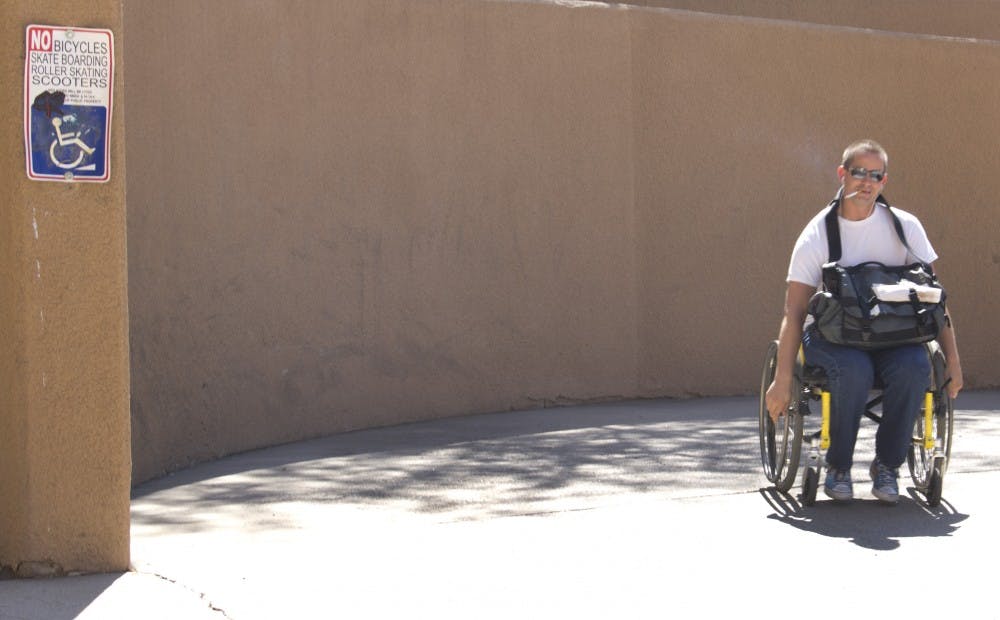news@dailylobo.com
Although the University will improve accessibility for *students with disabilities, some feel that the University’s response to necessary campus improvements has not happened quickly enough.
University Planning Officer Mary Kenney said the Facility Access Committee will install automatic doors in academic buildings around campus within the next month. She said the project cost $75,000 and was funded by the University’s Budget Office.
Kenney said the FAC voted in November 2011 to address as many doors that need automatic door openers as was financially possible. She said that so far, about 25 buildings, such as the Anthropology Building and Mesa Vista Hall, have been identified to be replaced with automatic doors and appropriate signage.
Kenney said that until 2008, UNM received general obligations bonds amounting between $350,000 and $600,000 from the state’s Higher Education Department every other year. But she said that in 2009, funding stopped and the FAC budget was limited to only $75,000.
Kenney said the project is proof that UNM is concerned with accommodating students with disabilities.
“UNM is constantly engaged in a proactive evaluation of our facilities, our financial resources and our implementation process to ensure full accessibility on all UNM campuses,” she said.
But UNM student Mary Connors, who uses a wheelchair, said the University’s efforts to improve campus accessibility are still not sufficient. Connors said that although the buildings are accessible enough, students with disabilities often find problems with ramps.
“There’s a ramp across from the SUB by the Education Building, and it has this really ridiculously high wall,” she said. “It clearly says no bikes and no skateboards, but (people) just don’t care. You can’t see anybody around the corner, and one time I’ve almost gotten hit.”
Connors said the ramp does not adhere to building codes because some ramps are steeper than what is allowed by the Americans with Disabilities Act, a law that prohibits discrimination against people who have disabilities. She said that because the ramps are hard to climb, it’s difficult for her to get to various parts of campus and arrive at her classes on time.
According to the 2010 Americans with Disabilities Act Standards for Accessible Design, ramps built after 2010 should have a maximum steepness ratio of 1:12, which means that every 12 inches of a ramp can have a maximum rise of 1 inch. In March 2012, the act mandated that ramps built prior to 2010 should have a maximum steepness ratio of 1:8.
“The ramp is too steep by code standards,” Connors said. “I need help to go up it, and I’m a pretty strong person. If you have (cerebral palsy) or (multiple sclerosis), that particular ramp is not really conducive. We pay to be here. If we can’t get to class, then what’s the point?”
Get content from The Daily Lobo delivered to your inbox
Connors said she has concerns about the S-shaped ramp near the Cornell Mall, which attracts a number of cyclists and skateboarders, especially during afternoons. She said she blames the University and security officers for not monitoring the ramps keenly.
“They don’t enforce the ‘no bikes, no skateboards’ rule. There are some times when I think a bicycle is going to come down that ramp and flip over me,” she said. “It seems like they don’t really care. I think they still think of us as outsiders, and we don’t need help and accommodations, but we do.”
Kenney, who did not confirm whether the ramp is up to ADA standards, said that the FAC has received multiple complaints about the ramp and plans to address students’ issues with the S-ramp as soon as possible, although it will take longer to repair the ramp permanently. She said the ramp doesn’t work efficiently for anyone who uses it and that a permanent solution would require significant redesign, which would be complex, long-term and expensive.
Kenney said that within the next 10 years, the FAC plans to improve the pathway from Roma Way to the Cornell Mall by removing the Education Classrooms building. She said removing the building is the only way to alter the sloped terrain of the area that makes the ramps so steep.
Kenney said the FAC will address other accessibility issues, such as clearer signage and the lack of handicapped bathrooms and elevator panels, in the future. But she said budget constraints greatly affect the FAC plans for remodeling and that the committee can only resolve problems that have available funding.
“There is a significant need for adequate funding to address accessibility issues throughout campus,” she said. “But the budget office is generously funding another $75,000 for this year, and strongly recommended that the FAC prepare a capital outlay request for the next GO Bond cycle in 2014.”
Connors said she hopes the University will listen to students with disabilities and fix the ramps as soon as possible. She said the University should monitor its budgets closely to improve the campus’ accessibility options.
“I want to see precisely where (the money) is going,” she said. “I would just tell them to make sure it’s noticeable that what they’re doing is helpful to the disabled community.”
UNM Honors College professor Leslie Donovan, who uses a wheelchair, said students have needed automatic doors in the past and that she’s glad that the problem is finally being addressed.
“I come over to Marron Hall quite a bit,” Donovan said. “The difficulty that I have is that there are no buttons for automatic doors and no elevators to go upstairs. (Installing automatic doors) is wonderful.”
Kenney said that although only some buildings will be updated within the next month, other buildings, such as Marron Hall, will be assessed and updated when funding is available.
Donovan said that UNM’s accessibility can still improve through the addition of Braille signage and renovations of elevators. But she said she does not blame the FAC for the lack of these features.
“They make a lot of effort,” she said. “But lack of funding makes many areas less accessible for people with mobility issues and visual disabilities.”
*This article originally read “disabled students.”






